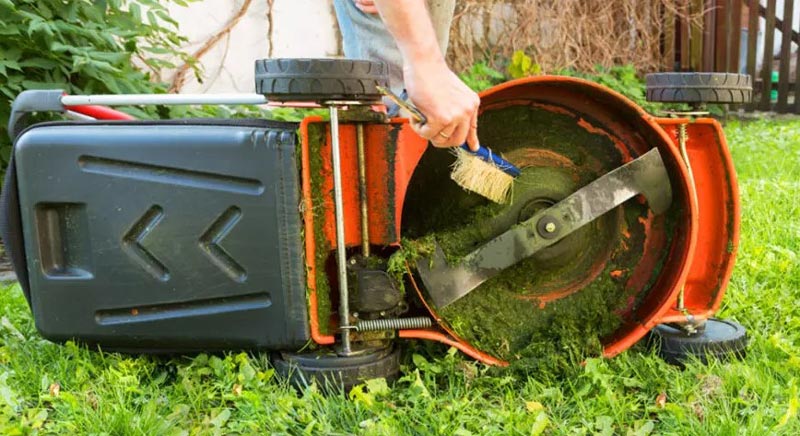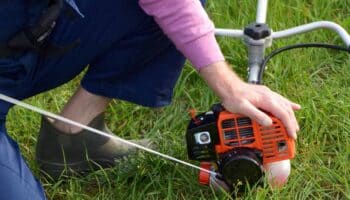When it comes to issues with a lawn mower, there are certain things you can accept as part of the cost of having equipment that gets used all the time and requires maintenance, whether it’s preventive or corrective.
These things can include power issues, blade damage, or even problems with the mower starting or stopping while it’s running.
What’s hard to accept is a mower that keeps getting clogged up.
Good news, though. Yes, a mower getting constantly clogged up is annoying but it’s also easy to correct and anticipate in the future.
So, if your mower keeps getting clogged up, it’s probably one of these issues, and here are the ways you can address each.
1. You’re Mowing Wet Grass
Nothing clogs up a mower faster than wet grass. Here’s the thing, though. Mowing wet grass is so very avoidable.
As in, if your grass is wet, don’t mow it. Wait for it to drive and then mow to your heart’s content.
In the meantime, when it’s wet, leave your lawn alone. It’ll save you the frustration of dealing with not only a clogged mower but you’ll also avoid the clean-up that inevitably comes with mowing wet grass.
Lastly, you’ll avoid the possibility of electrical shock if you have an electric mower and possible damage to your mower’s blades, chute, and bag.

2. You’re Mowing Grass Taller Than You Should at One Time
Wait a second. Isn’t the whole point behind mowing grass that it’s too tall and needs to be cut?
Yes and no.
The main strategy behind mowing your lawn should be to keep it from getting too tall. However, if time and conditions have gotten away from you, yes, your too-tall lawn needs to be cut.
That doesn’t mean you’re supposed to cut it down to the appropriate height all at once.
If you cut tall grass too fast, you’re going to be cutting more volume than the mower is designed to handle at a given time. This can result in not only a clogged mower but also potential damage to the mower, overheating, and your mower cutting off before you get too much done.
Instead, mow your tall grass over several days, adjusting the mower height lower each time you do it. This will keep the volume of grass the mower is handling normal while also preventing your mower from clogging up unnecessarily.
3. Your Grass Catcher Bag Needs Cleaning
One of the parts of your mower that a lot of people don’t think about getting clogged but absolutely can is your mower’s catcher bag.
“How can a bag get clogged?” you might wonder.
Well, part of the way the catcher bag works is by allowing air to flow through the bag through what is effectively mesh material. If it’s clogged, the airflow will be poor to non-existent, causing clippings to collect in the chute or underneath the mower deck.
So a clogged bag can lead to a clogged chute can lead to a clogged mower deck.
This means it’s time to do some grass bag cleaning. This can be accomplished with forced air (like a leaf blower or pressurized air duster), muscle, or water.
If your grass bag is clogged, take a stiff brush to clean off the old, matted clippings inside. Don’t want to give it the old manual labor-try? Then pull out that leaf blower and blow the bag clear. If you’ve got a power washer, that would work better than any other choice.
Now, if you brush or blow out or power wash your bag and it starts to fall apart, it’s time to realize the one thing that was probably keeping it held together was the matted grass. In such a case, or with any grass bag that’s damaged, replacing it is usually the easiest way to correct the problem.
If you want to get any replacement part – or see how much one would cost – click to enter your model number in the search bar below. Our partners at AppliancePartsPros stock almost every part with free guides on how to install them.

4. Your Mower Grass Chute is Clogged or Almost Clogged
Just because you emptied your grass bag and cleaned it out doesn’t mean your problem is completely taken care of. If your bag was coated with matted, dried grass then the same is probably true for your grass chute.
If you’re unsure of what the grass chute is, it’s that little doorway-looking thing that forms the path between the mower deck and the bag. In other words, it’s the path the clippings follow once cut before landing in the bag.
However, if your bag’s clogged or, for example, you’ve been mowing wet grass, that path can quickly become a choke point.
Or clog point.
The bottom line, though, is it’s a very easy place for grass to collect, and if the air flow through it to the bag is restricted, the buildup is only going to get worse and worse.
The solution for a clogged chute is similar to a clogged bag. Your options, once again are air, muscle, and water.
Unlike the catcher bag, though, and depending on the design of your mower, you’re probably going to have to use more muscle with a clogged chute simply due to the smaller opening and to address any crevices grass may have found itself jammed in.
For this type of work, a brush with rigid bristles and a flathead screwdriver or putty knife come in handy.
Once your chute is clean, apply a coat of WD-40 around the perimeter to make it slicker and harder for clippings to collect.
5. Your Mower’s Blades are Damaged
It should go without saying that damaged mower blades can lead to a whole host of problems. One of those problems happens to be clogging.
Why? Well, damaged blades mean you’re not getting cuts the way you’re supposed to. You might be getting fine cuts with one side of the blade and chunky cuts with the other side. Inefficient cuts lead to grass piling up and caking and then clogging.
Also, damage to the blades could lead to the blade assembly being unbalanced. This can lead to not only chunky and uneven cuts but also large sections of turf being cut and ripped up. With that kind of action, you’ll be getting more soil mixed in with the grass under your mower, around the chute, and in the bag.
The fix here is, of course, to inspect your blades and replace them if there’s any sign of damage.

6. Your Mower’s Deck Needs a Good Cleaning

A mower deck covered with caked grass may be the beginning of your clogging problems. Think of it as a cascading casualty. A dirty mower deck can lead to damaged and grass-caked blades that can lead to a dirty and clogged chute and bag. Throw in tall or wet grass and you have a perfect recipe for mower clogging in not just one but a handful of areas.
So, your mower deck, along with your catcher bag, chute, and blades, could probably use a good visual inspection and cleaning.
Actually, all of these areas should be cleaned after every use. Maybe not to the level of power washing each time but a good wipe-down and sweep never hurts.
Back to the mower deck. As noted, brushing it off, blowing it down, or washing it off is always an option and all of them are worth a look. Also, if you do have caked grass on the deck, that putty knife would be an appropriate tool for scraping all the gunked-up debris.
If you’re lucky to have a mower with a port on the deck for hooking up a hose, even better. Make use of it as it’s an easy way to push water throughout the surface of the mower deck for a quick rinse.
When you’re done cleaning, like the chute, apply a coat of WD-40 or another industrial lubricant to keep the surfaces clear of future debris. Find your lawnmower’s manual below.
Conclusion
A mower that clogs up all the time is annoying and, if not corrected, can lead to more headaches than they’re worth.
If you try out the recommendations above you should, hopefully, be able to clear up your clogging issue and prevent it from being more than an annoyance down the road.








